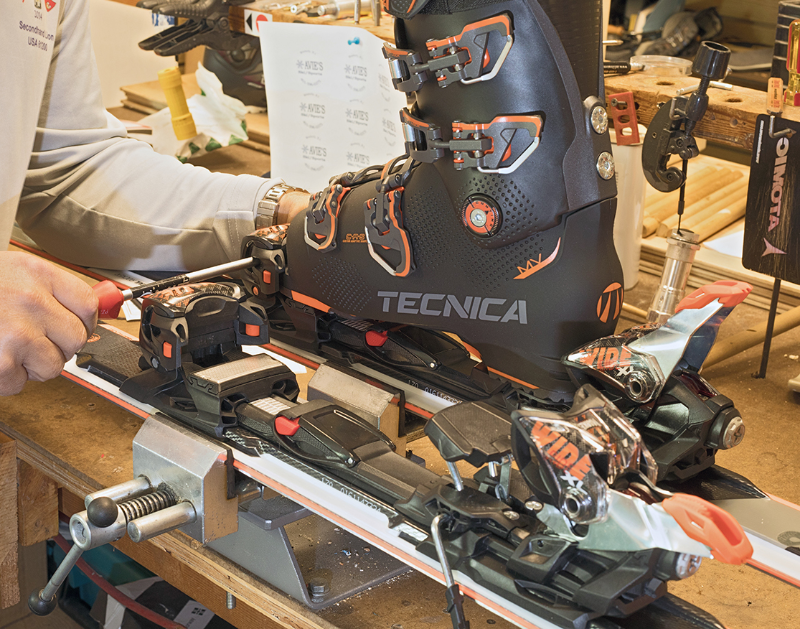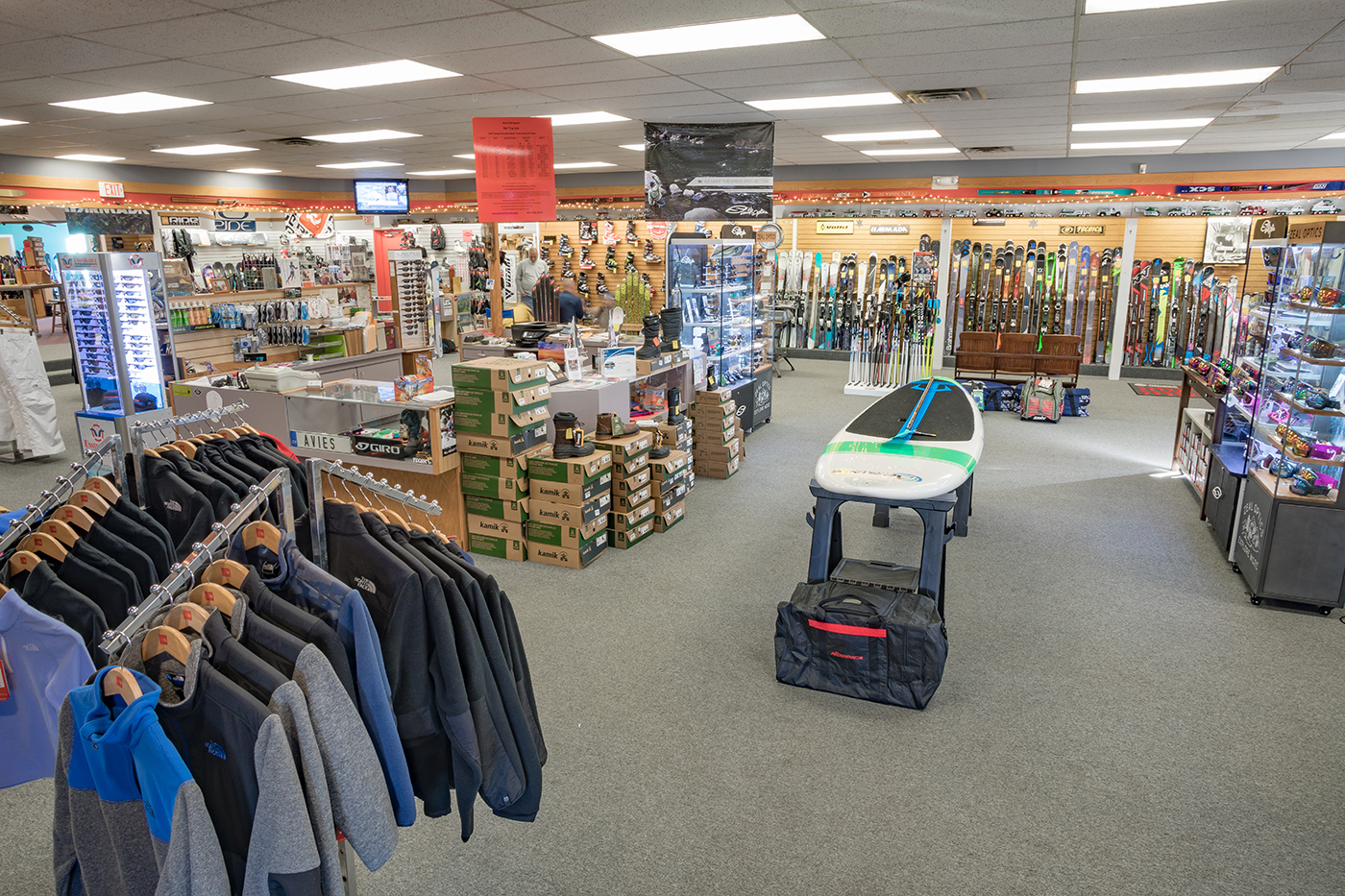
ski bindings, simply complex…
Ski bindings attach you, and your ski boot, to the ski. Pretty simple? Yeah, but not really. Ski bindings are a lot more than a simple clamping mechanism you step into so you can attach to the ski.
A primary function of the ski binding is to take the energy you put into your ski boots from your legs and transfer it to the skis. A secondary function, but a priority task for ski bindings, is to release the boot from the ski binding, when appropriate. Such as when you take a tumble. Just as important, it is critical that the ski binding NOT release the boot when inappropriate. Such as as when you are skiing.
Bindings can be an integral part of the ski, such as in a system ski, where binding and ski are designed as a functional unit. Or a la carte, where bindings are purchased separate of the ski and mounted onto the ski by a certified technician. See “Skier Need To Know—Flat vs System Ski” for more details.
Ski bindings are simply complex!
Regardless the set up of the binding on the ski, all bindings perform the same basic, though complex functions that promote skier safety. Certified ski technicians adjust bindings to account for skier height, weight, age, ability, and length of the sole of the ski boot. These vital data are used to set a DIN value—the industry standard for ski binding release settings. A DIN value is set on the ski bindings so that they release the ski boot when appropriate, such as in a fall, but keep the boot attached to the ski otherwise. The higher the DIN setting, the more force needed to release the boot from binding.
DIN is set at both the toe and heel sections of the ski binding. The toe section of the ski binding allows for reaction to twisting (side-to-side) forces. When the twisting force exceeds the DIN setting, the ski binding releases the ski boot from the ski binding to the side. The heel portion of the ski binding allows for reaction to forward applied (back-to-front) forces. When the forward applied force exceeds the DIN setting, the ski binding releases the heel of the ski boot from the ski binding in an upward direction.
Ski bindings promote skier safety
In this fashion, the ski binding allows the skier to detach from the ski when “normal skiing forces” are exceeded. This reduces the probability for an injury to occur when a skier takes a tumble.
Beginning skiers generally have lower DIN settings than a proficient skier of the same age, weight, height and boot sole length. Beginning skiers make lots of mistakes as they learn how to control their skis. Those mistakes often result in lots of spills and tumbles. Having the skis release readily is a benefit that promotes safety.
As skiers progress in their ski handling technique, DIN settings are increased. Why? Because a more proficient skier is exerting more pressure and greater force from ski boots into the ski binding and into the ski. If DIN setting remained at novice levels, better skiers would be getting ejected from their skis at very inappropriate moments! And that would not be a good thing. Not at all.
A further task of ski bindings is to account for the deformation of the ski during the act of skiing. For instance, as a ski is pressured through a turn, the ski is bending along its length. Even under the ski binding. That means the heel and toe of the ski binding are getting closer to each other. Not a big deal, except that the sole of that ski boot you are wearing is NOT bending. Not one little teensy bit. If the ski binding did not account for that movement, the skier would be launched from the bindings! And that would not be a good thing. Not at all.
Certified technicians are a must
Certified ski technicians also set what is referred to as forward pressure on a ski binding. Forward pressure is determined by the length of the ski boot sole, and allows for a range of movement at the heel of the ski binding, to account for the deformation (bending) along the length of the ski.
Hence the need for a certified ski technician to be sure that DIN and forward pressure adjustments are set correctly for the weight, height, age, ability, and boot sole length of the skier. A Do-It-Yourself approach to setting up your own ski bindings is a sure way to shorten your ski season. Why? Because it’s not possible to ski with a full-body cast.
One further feature of note is the ski brake. Ski brakes are the little arms hanging off the sides of the ski at the heel portion of the ski binding. The ski brake has an obvious function, given away by the name “ski brake.” Once the ski binding releases the ski boot, hopefully avoiding injury to the skier, the ski is now free and clear. The last thing we would want to happen would be to have that ski go off on its own, downhill. That would not promote skier safety for all those down slope of fallen skiers. Not at all.
So it’s a good thing that ski bindings have ski brakes. Upon stepping into the ski binding, the ski brakes lift up out of the snow and out of the way. Once the boot is released from the binding, the ski brake snaps down—forcefully—into the snow. The ski may go a short distance, but not very far.
A final word on ski brakes. You need to be sure that the ski brakes for your bindings are wide enough to extend beyond the width of the ski. If you buy your bindings at a shop, Avie’s Ski / Sports for instance, that will happen automatically. But if you purchase bindings on your own, you need to get the correct width ski brake for your ski. If not, the certified technician won’t mount you’re bindings until you purchase the correct size ski brake.
High tech and complicated
Ski bindings are high-tech, complicated pieces of equipment. Don’t mess with them other than keeping them clean and rust free. Rinse them with fresh water, especially if you use an external, open, roof-rack ski transport system to get your gear from home to the slope and back again. Road salt gets all over skis and bindings, and begins to corrode metal almost immediately. Rinse your skis and store them somewhere warm and dry so they don’t rust or corrode.
Buying bindings is not particularly complicated. Most ski manufacturers have a suggested binding matched to their skis. That’s a good starting point, and you won’t go wrong following their recommendations. But you can mix-and-match, at least to some degree. You may want to check out “Skier Need To Know—Flat vs System Skis” if you aren’t familiar with the difference, before reading further.
Skis configured with a system binding may however, only be compatible with a specific binding or bindings. Why? Because the manufacturer designed and built ski and binding to function together in a predictable fashion.
On flat ski set ups, you are free to choose the maker and style of binding that best fits your needs. While not discussed here, alpine touring ski bindings would be one of those options.
When purchasing ski bindings, there are a few things to consider. The first and foremost is to ensure that the ski binding has the range of DIN settings appropriate to your abilities and skiing style. For example, the Marker Griffon 13 ID has a DIN range of 4.0 to 13.0. The Squire 11 has a DIN range of 3.0 to 11.0m and Squire 10 from 3.0 to 10.0.
When selecting bindings you want to choose one that your DIN setting will fall somewhere in the middle part of the range, not at one of the extremes. Why? Because ski binding settings are the most consistent at the mid part of their settings range. It also leaves you a bit of adjustment room should your DIN setting change, but still leave you somewhere in the middle portions of the DIN setting range for that ski binding.
A few things to keep in mind when buying used ski bindings…
As noted above, you would want to check the binding DIN setting range to be sure they were appropriate for your use. You would also want to know if the ski binding is indemnified. This is critical.
Indemnification means the ski binding manufacturer supports a certified technician setting release values on that ski binding. If a ski binding is no longer indemnified by the manufacturer, then certified technicians will not work on the ski binding. Why? Because the manufacturer does not support them doing so. If the user were to get injured while skiing, the manufacturer would simply say “We no longer support that binding as we cannot fully be sure that it will function as designed and release the skier as expected.” Certified technicians won’t adjust a non-indemnified ski binding because they don’t want to be held liable in a lawsuit, should one arise because of skier injury. The manufacturer isn’t willing to support the binding, so why should the certified technician put themselves on the front line of a possible law suit?
Does that mean that a non-indemnified ski binding is unusable and unsafe? Not necessarily. But it does mean that you use it at your own risk, with the understanding that the manufacturer no longer considers it fully reliable.
Think of it this way. The major functional parts of a ski binding that holds or releases a skier from the binding are springs. How much faith do you want to put into a spring that has been compressed for say, 10 or more years? Keep in mind that during that span of time the spring has been fully compressed, subjected to thawing and freezing, doused with water and salts, and most likely left between seasons to get nicely rusted and pitted.
The bottom line is, if you pick up a pair of used skis and have no idea how old the bindings are or if they are indemnified or not, you run the risk of owning a pair of skis that no certified technician will adjust. Sure, you can purchase new bindings and have them mounted on the used skis by a certified technician. But your bargain buy all of a sudden became much less of a good deal.
How can you tell if a binding is indemnified? You would have to check with a ski shop to see if that specific binding is on the most current indemnification list or not. If you have a good relationship with a local ski shop—you shop there, buy gear there, have skis tuned there, etc.—then it is reasonable to ask if they would confirm a used ski binding you might find as being indemnified or not. A cold call to a ski shop you have no connection with may not be productive.
We are not suggesting you shouldn’t purchase used skis and ski bindings. It does mean that there is a certain amount of risk in doing so, particularly if the skis and bindings are older. You can mitigate that risk by being prudent, and may negate the risk if you have a good relationship with a local ski shop.
For a bit more on indemnification see Binding Indemnification…A Bit More.
GripWalk Is Shaking Things Up
GripWalk is a new boot sole design that debuted in 2015-2016 and is now the industry standard for ski boots. There are some considerations and issues regarding compatibility of GripWalk with older ski bindings. Fortunately there is sometimes a fix. Unfortunately, not always. See the “Skier Need To Know—GripWalk” page for more detail.
[updated October 2022]
